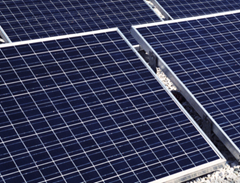New Study Zeros In On Releasing Sun’s Energy
American Institute of Physics Reveals More Productive Selenium photovoltaic cells
by Rosalind Sanders

Many scientists would love to discover a low-cost way to convert the sun's power into carbon-free electrical
energy. A team at the Lawrence Berkeley National Laboratory in Berkeley, California, is very close to that
discovery!
The magazine Applied Physics Letters (August 2010) published a new analysis describing how solar energy
could potentially be collected using the element selenium. The article, published by The American Institute of
Physics, discussed how the Berkley team inserted selenium in zinc oxide, a relatively inexpensive component that
could make more effective use of the sun's power. Even a relatively small amount of selenium – just 9% of the
mostly zinc-oxide base – considerably raised the material's efficiency in absorbing light.
The key author of this research is Marie Mayer a fourth-year University of California, Berkeley doctoral student.
Mayer affirms that photo-electrochemical water splitting – that signifies employing power from the sun to cleave
water into hydrogen and oxygen gases – could probably be the most exciting future application for her work.
Harnessing this reaction is key to the eventual generation of zero-emission hydrogen powered motors, which
hypothetically will run only on water and sunlight.¹
The “conversion efficiency” of a PV cell is the portion of sunlight energy that the solar cell converts to
electrical energy. This is very important when discussing photovoltaic units, because boosting this efficiency
is vital to making photovoltaic electricity competitive with more traditional sources of energy
(e.g., classic fuels).
For comparison, the first photovoltaic units converted about 1%-2% of sunlight energy into electrical energy.
Today's PV units convert 7%-17% of light energy into electrical energy. The cost to produce the PV devices has
also been enhanced over the years. Today's systems produce electricity at a fraction of the cost of the first
PV systems.
In the 1990s, when silicon cells were two times as thick, efficiencies were much lower than today and lifetimes
were shorter. It may well have cost more energy to make a cell than it could generate in a lifetime! In the
meantime, the technological innovation has developed considerably. The “energy repayment time” (the recovery
time necessary for generating the energy spent to manufacture the respective technical energy systems) of a modern
photovoltaic module is usually from one to four years, depending on the module-type and location.
Normally, thin-film technologies – despite having relatively low conversion efficiencies – obtain significantly
shorter energy payback times than standard systems (often less than one year). With a common lifetime of 20 to 30
years, this signifies that contemporary photovoltaic cells are net energy producers – they produce significantly
more energy over their lifetime than the energy expended in producing them. □
About the writer - Rosalind Sanders contributes articles for the
Solar Pool Cover Ratings
blog, her personal hobby blog based on tips to help home owners save energy with solar power.
1. Marie A. Mayer et all. Applied Physics Letters, August 2010
[link: http://link.aip.org/link/APPLAB/v97/i2/p022104/s1]
